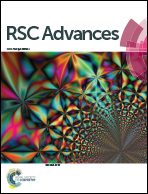Label-free and turn-on fluorescent cyanide sensor based on CdTe quantum dots using silver nanoparticles
Abstract
Silver nanoparticles were used to develop a simple turn-on fluorescent assay based on glutathione-capped CdTe quantum dot for the determination of trace amounts of the lethal poison, cyanide. It was found that the fluorescence intensity of glutathione-capped CdTe quantum dots increased with increasing cyanide concentration. Several experimental variables, such as pH and amounts of quantum dots and silver nanoparticles and their effect on the analytical signals, were optimized. Using this optical sensor under optimum conditions, cyanide was measured in the range of 0.01–2.5 μg mL−1 with a detection limit as low as 0.004 μg mL−1. Relative standard deviations of 2.0% (for 0.5 μg mL−1, n = 10) and 1.8% (for 2.0 μg mL−1, n = 10) were obtained. Investigation of the effects of potential interfering anions on the response of the sensor revealed its high selectivity for the detection of cyanide in real samples. High sensitivity, superior selectivity, low detection limit (0.004 μg mL−1) and ease of production are the most important advantages of the present sensor. Finally, the sensor was applied for the determination of cyanide in real samples.


 Please wait while we load your content...
Please wait while we load your content...